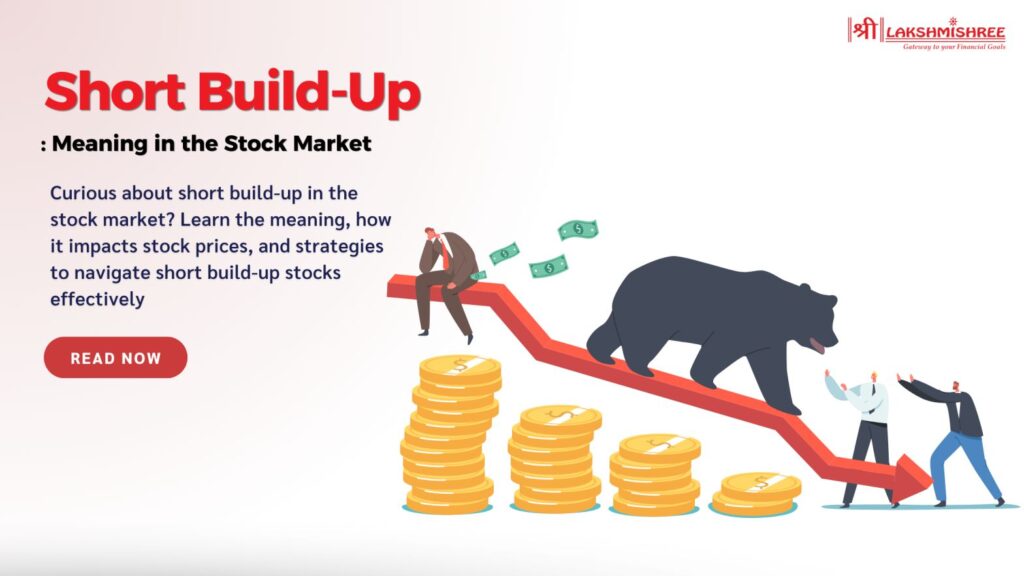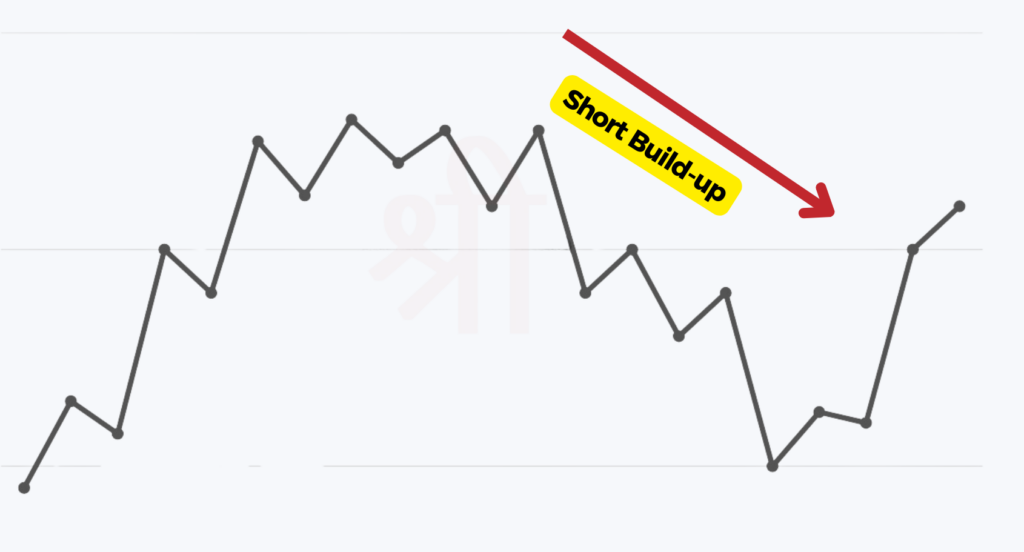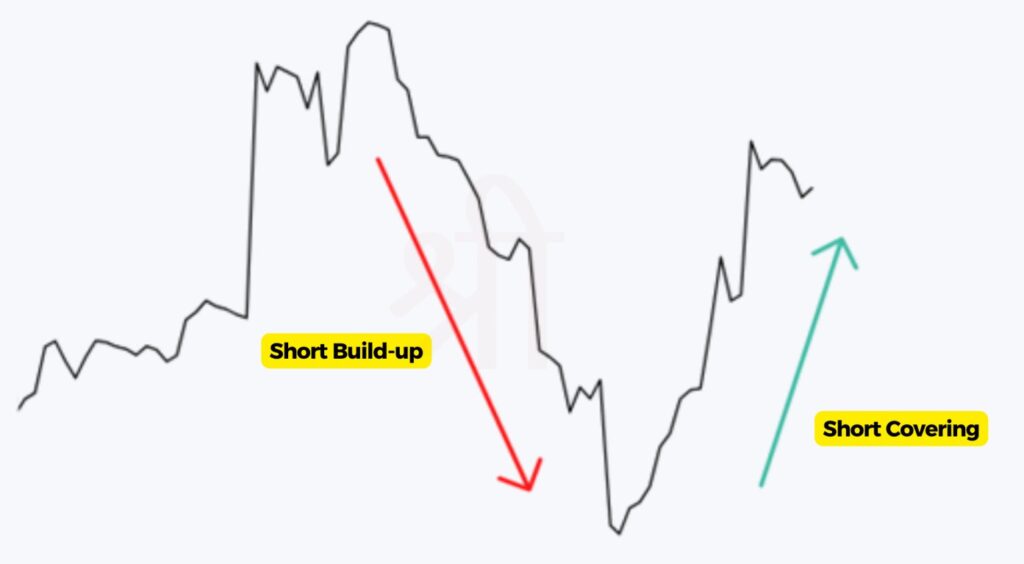
In the stock market, terms like short build-up can often sound confusing, but the idea behind them is actually quite simple. It happens when more traders start betting that a stock’s price will decrease. This usually means the stock is under selling pressure, which signals a bearish (negative) outlook for that stock.
Understanding the short build-up meaning is important for traders because it can help you determine the market sentiment around a particular stock or index. In this blog, we’ll explain what it is, why it happens, and how you can use this knowledge to make better trading decisions.
In the world of trading, the term short buildup refers to a situation where traders take more short positions on a stock or index, expecting its price to fall. This occurs when the price of a stock is declining, but at the same time, the open interest (the total number of outstanding contracts) is increasing. Essentially, a short build-up meaning is tied to bearish market sentiment—traders believe the stock or index will drop further and act accordingly.
Simply put, traders are betting against the stock during a short build-up. They sell at the current price, intending to buy it back later when it has dropped. This activity reflects increased selling pressure in the market, a key indicator of negative sentiment surrounding the stock or market in general.

It can occur for various reasons, often linked to market sentiment, speculation, or even hedging strategies. Here are the main factors:
Understanding the short build-up meaning can provide valuable insights into market trends and help you make smarter investment decisions. Here’s how:
In the stock market, short and long build-up are indicators of market sentiment, but they point in opposite directions. While a short build-up signals bearish sentiment—where traders bet on falling prices—a long build-up reflects bullish sentiment, with traders expecting prices to rise.
| Factor | Short Build-Up | Long Build-Up |
|---|---|---|
| Definition | Increase in short positions with a drop in stock price. | Increase in long positions with a rise in stock price. |
| Market Sentiment | Bearish (expecting prices to fall). | Bullish (expecting prices to rise). |
| Price Movement | Price declines as selling pressure builds. | Price increases as buying pressure builds. |
| Open Interest (OI) | OI increases as traders take more short positions. | OI increases as traders take more long positions. |
| Objective | Traders aim to profit from price declines. | Traders aim to profit from price increases. |
| When It Happens | Common during negative news, weak fundamentals, or panic selling. | Common during positive news, strong fundamentals, or market rallies. |
| Risk | Risk of sudden price rallies due to short covering. | Risk of price drops due to profit booking or market corrections. |
Navigating stocks experiencing a short buildup requires market analysis, risk management, and timing. Here are practical strategies to help you make the most of these situations:
Open Interest (OI) is the key to identifying momentum. A rising OI with a falling stock price means bearish activity. Combine this with price-volume charts to confirm the trend. For example, if OI goes up 10% and the stock price drops 5%, it’s a short buildup.
Keep an eye on stocks with high short-interest ratios. If any positive news or event occurs, traders covering their short positions can lead to a price surge. You can position yourself strategically to take advantage of this rally.
Pro Tip: Use tools like the Put/Call Ratio to gauge market sentiment. A higher ratio often signals bearish trends, indicating a short momentum scenario.
If you already own a stock experiencing a short build-up, consider hedging your position using derivatives like options. For example, buying put options can protect your portfolio against significant price declines.
Stocks with a short buildup often show extreme volatility. If you’re a long-term investor, avoid reacting impulsively. Analyse the stock's fundamentals—if the short build-up is driven by temporary market conditions or speculative trading, the stock might recover in the long term.
You need access to good tools and indicators that give you actionable insights to identify and track a short build-up. As a trader or investor, these tools will help you spot trends, understand market sentiment and make informed decisions. Let’s look at the key tools and data points to watch:
As a trusted stockbroker, we provide all the essential tools and real-time data you need to analyze and track short moments effectively:
While both involve short positions, they represent opposite phases in market activity. A short build-up happens when traders increase their short positions on a stock or index, expecting its price to decline further. On the other hand, Short covering occurs when traders close their short positions by buying back the shares they sold earlier.

| Factor | Short Build-Up | Short Covering |
|---|---|---|
| Definition | Increase in short positions with price declines. | Closing of short positions by buying back shares. |
| Market Sentiment | Bearish (expecting prices to fall). | Bullish (as prices rise due to buying pressure). |
| Price Movement | Price declines due to selling pressure. | Price increases due to sudden buying pressure. |
| Triggers | Negative news, weak fundamentals, speculation. | Positive news, technical triggers, loss recovery. |
| Impact on Market | Reinforces downward momentum. | Leads to a sharp upward rally or "short squeeze." |
Imagine a stock priced at ₹800 showing signs of a short build-up. If negative sentiment continues, the price might drop to ₹750. However, a positive earnings report could trigger short covering, causing the price to jump to ₹850 due to traders buying back their positions.
Understanding short buildup in the stock market is important for making informed trading decisions. The short buildup is a bearish sentiment where traders increase short positions in anticipation of price decline But these are also opportunities for smart investors to navigate the market trend through hedging, avoiding risk or capitalising on short-covering rallies.
The short build-up meaning goes beyond just a bearish signal—it provides insights into market behaviour and helps traders stay ahead of the curve.
A short build-up happens when traders increase short positions on a stock, expecting its price to decline further. This is indicated by falling prices and rising open interest, signalling bearish sentiment in the market.
Not necessarily. While a short build-up signals bearish sentiment, it doesn’t guarantee that prices will continue to fall. Factors like market news or short covering can reverse the trend and cause prices to rise.
In futures trading, a long build-up indicates an increase in long positions with rising prices, reflecting bullish sentiment. A short build-up, on the other hand, occurs when short positions increase as prices fall, reflecting bearish sentiment.
Short covering occurs when traders close their short positions by buying back the shares they sold earlier. This buying activity can drive prices up, often leading to a sharp upward rally known as a short squeeze.
It is considered bearish because it indicates that traders expect the price of a stock or index to decline. It reflects negative market sentiment and increased selling pressure.
Disclaimer: This article is intended for educational purposes only. Please note that the data related to the mentioned companies may change over time. The referenced securities are provided as examples and should not be considered recommendations.